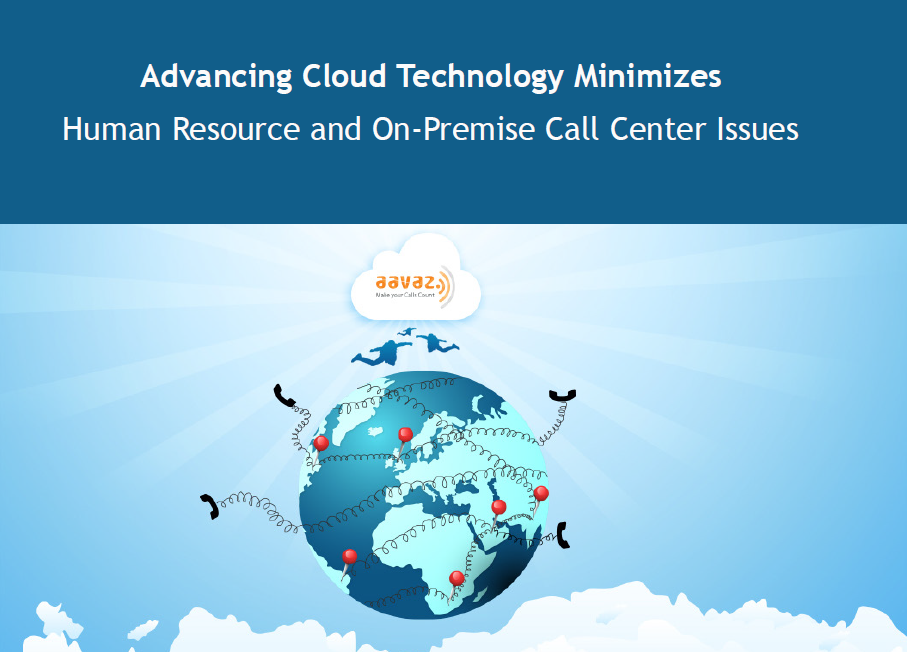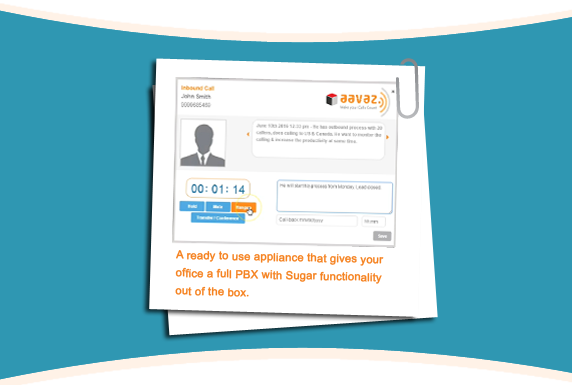Advancing Cloud Technology Minimizes Human Resource and On-Premise Call Center Issues

Adopting new technology for large organizations requires preparation, rounds of discussion among department heads, trials and a paradigm shift in the existing system. Despite the challenges, the call-center model is changing from on-premise to cloud-based call technology. What may initially appear as an unwelcome disruption to the established process eventually becomes a pivotal improvement in call center operations. Mature technology streamlines existing processes to simplify employee supervision with virtually no change to call center management practices.
The cost-benefit analysis of the cloud topples the existing dogma that employees must be on-site and visible to the managers. In turn, the supply of this old-model labor is dwindling while the talent pool remains enormously un-tapped. Two major concerns dominate call-center dynamics, whether cloud-hosted or on-site:
● Employee Acquisition, Retention and Attrition
● Beating Attrition with Alternatives that are Quick, Manageable and Reliable
Employee Acquisition, Retention and Attrition
90% of call center managers identify costs and staff related issues as their biggest challenges. They have three primary concerns in maintaining a consistent, competent workforce:
● Turnover
● Manpower shortage
● Providing consistent training
Beating Attrition with Alternatives that are Quick, Manageable and Reliable
The cloud has long held the promise of addressing these issues, but faced the challenge of overcoming the notion among managers that they would lose control of the workforce and its output if they adopted cloud technology.
Cloud call technology provides the tools necessary to maintain control through strong reporting and monitoring tools that are now available even for distributed centers. This technology provides three essential components to meet the traditional challenges of on-premise call centers:
● Easier than ever on-boarding
● Meeting quantitative goals
● Ensuring quality delivery
This white paper addresses each of these on-premise problem areas and states the case for cloud operations as a solution to these problems.
1. Turnover
With average turnover rates at a call center as high as 50%, the resources going into recruiting, on-boarding and training are 50% wasted and surrendered to attrition. Call centers have learned to mechanize and automate their business processes in anticipation of this waste. It is a part of their business model.
Essentially, traditional call centers embed excessive business costs into their processes because they have to account for the fact that 50% of their employees will leave. Over-investments are made into employee insurance, travel arrangements to and from the centers, security, program installation, training, IT related activity (computer, usernames/passwords, computer hardware maintenance, system crashes etc), additional rental space and overstaffing of campaigns to ensure SLA’s are met. All these over-investments hurt the bottom line— and call centers are all about controlling the bottom line, both for their clients and their competitive edge.
Lifestyle and career development issues contribute heavily to turnover. Employees typically change jobs for three reasons:
● Dissatisfaction with the workplace which manifests from co-workers and/or office politics
● Life changes like moving, getting married or relocating for a spouse’s career
● Vertical improvements within career such as promotions or salary increases
Unlike the on-premise model cloud technology enables companies to offer employment opportunities that allow staff to remain on the job as their lives and circumstances change.
“The average longevity of my staff with TSRI is over 5 years– something almost no other call centers could ever boast”- Rick Meares
Additionally, cloud technology alleviates the manager’s challenge of scrambling to replace these employees. Hiring new employees can be done swiftly and without the stress of arranging travel, office orientation, equipment installation or any other typical office chores.
A company can easily maintain a standby pool of employees for emergencies—think highly educated stay at home moms or physically disabled but perfectly call center-abled people who are waiting to turn their free time and talents to income. A variety of people would happily be associated with a call center if they were allowed to bypass the demands of commute and lifestyle by working from home.
If an employer needs a common work environment for their staff – imagine a small center that requires only a Wi-Fi connection and basic laptops. This minimal investment was previously unimaginable as every center once required heavy investment in telephony and server equipment and faced issues with data silos. Now call centers can hire full time employees in these small centers that live outside of the typical call center locations such as Tier 2, 3 and even Tier 4 cities. Centers would be fully connected via the cloud to form a larger whole. Employers can challenge the norm by managing a (grateful) workforce remotely.
Rick Meares, the founder and COO of TSRI in Florida and an early adopter of cloud call center technology, operates an entirely remote workforce of over 100 well-trained, full time stay at home employees says “The average longevity of my staff with TSRI is over 5 years– something almost no other call centers could ever boast”. His company has been operating this way for over 10 years and he sees no other way of conducting business than using cloud technology.
2. Manpower Shortage
When call centers are limited to denser areas, the manpower shortage is more acute. In countries like the Philippines, India and other large call center locations, the demand is greater than the supply.
Manpower shortages present themselves in many ways. Not every call center agent is the same. An employer may need specific skills in financial areas, or technical support or health care. There may be labor available, but without the right skills. The cloud enables managers to tap into skilled labor wherever it exists.
The cloud also enables a workforce to scale on demand. As clients grow, campaign test metrics need proving or marketing campaigns cause a surge in call traffic, management is not limited to hire from the surrounding geographic area.
3. Providing Consistent Training
Traditional training in business processes is cumbersome, involving complex software and complicated procedural requirements to safely store and exchange data. The advantage to using a Cloud-based model is two-fold:
1. Its cutting-edge technology automatically means better usability, making training and caller logic fool proof:
● Ease of use by natural virtue of newer generation technology
The latest generation of cloud call center solutions requires almost no training and can work through a browser or mobile phone, on low-end configured laptops or even inexpensive Chrome books. Planned on-boarding sessions can easily be achieved with pre-recorded or live webinars.
Business process training can also be done remotely. When moving to a distributed model, insist on the system that requires the minimum software overhead, as supporting a multitude of software can become tricky. The best in bunch literally work on a browser or Chrome book.
2. Cloud accessibility: on-demand training and remote monitoring make training attractive and more accurate for a manager and a caller
● Meets quantitative goals
Quantitative reporting is crucial beyond measure to clients as well as managers who are running call centers and calling campaigns. With detailed call reporting, managers are armed with a viable account of metrics based on real activity. Detailed metrics like call length, and disposition can be gathered on the fly, making information gained more timely and therefore more valuable..
Quantitative reporting is the catalyst for quality assurance and SLA compliance. All campaigns fall into statistical norms when it comes to certain metrics. Experienced call center managers are good at being able to identify and spot issues that arise simply by looking at the numbers.
For outbound campaigns, metrics can largely be divided into 3 large categories
● Dial metrics
● Call disposition metrics
● Performance metrics
Dial metrics largely depend on the quality of the lists. These typically yield an overall indicator of dials per hour, good or bad numbers or answering machines – numbers that measure what happens before your agent speaks to someone. Call disposition metrics give an indication of how well the people on the list respond to the message being delivered; and performance metrics give an indication of how well the caller is achieving the high level goal of the campaign -whether appointments per hour or event registrations per day.
A simple example: If calling businesses, then most calls will be answered. Limitations naturally fall at a max of about 30 calls an hour. Consumers on the other hand can vary a lot more. When cold-calling [or dirty-dialing] out to unknown numbers – the number of dials could be very high, with a much smaller number of connects.
All call center systems should provide these metrics. But with the real-time, tight integration between the voice carrier technology and the contact management, cloud call systems leave the on-premise model in the dust when it comes to catching problems- as they are actually occurring. No time is wasted walking around and listening to agents. Instead, a manager’s valuable time is spent processing the results and addressing the problem areas the technology identifies.
● Ensures Quality Delivery
According to FlexJobs.com, “regular telecommuting grew by 79.7 percent between 2005 and 2012, and that doesn’t even count people who are self-employed and working from home”.
Often, and understandably, the biggest barrier to transforming operations from on-premise to cloud is the failing to understand that statistics prove that telecommuting is on the rise without detriment to business operations. Businesses that discount this trend lose ground to those who accept it.
Quality delivery depends on quality hiring. Cloud technology expands the labor pool beyond the geographic area. Good hiring must include interviews on the phone: a perfect opportunity to judge a candidate’s phone manner and learning-curve on the software with screen share; and to record their disposition for your boss to approve; and to monitor their phone disposition. A hiring manager wouldn’t have to worry about much else.
Quality control for the typical on-premise call center depends on he wasteful practice of several managers listening into live calls.
The better way is to review the quantitative reports and identify metrics that don’t fit the statistical norm. Cloud call centers have evolved to allow for managers to listen, whisper or cut in to live calls to fulfill the needs of the old ways But the greatest value of cloud technology is the ease and speed it offers managers in identifying problem areas. Once identified, they can dig up the detailed call reports or listen to the recordings of the particular campaign or caller in question. The recordings and metrics point to the solution whether it’s training, tweaking the message, or some other solution.
Good detailed call records, that are easy to access and even easier to share also solve customer disagreements. When the client feels that certain SLA’s are not being met, the reports and recordings help to have meaningful discussions with real metrics and real live information that help to resolve matters quickly.
Conclusion
Cloud call center software helps alleviate attrition and manpower shortages by offering advantages unavailable to on-premise centers. The rapidly advancing technology presents the ability to run extremely detailed quantitative reports with recordings as well as live monitoring. This combination delivers a higher level of performance and more flexible, agile solutions than the traditional on-premise model.
The question of converting operations has been answered. Cloud technology is inevitable and evolutionary. With limited barriers to entry- it is a no brainer. Don’t get left behind.








